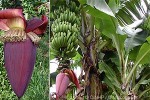Cook Islands Biodiversity Database
Species Page
Musa (AAA group)
Meika ‘ĀmoaCavendish Banana
Multimedia & Additional Resources
| Type | Description | Download |
| Leaves, fruit, and male flowers | 81KB | |
| Musa AAA and Musa AAB | 69KB |
General Information
Cook Islands Distribution
| Southern Group: Present Makatea: Present | ||||||||
RR |
MG |
AT |
MK |
MT |
AK |
PL |
TK |
MN |
++++ |
++++ |
++++ |
++? |
P |
P |
- |
||
| Northern Group: Present | |||||
TN |
MH |
RK |
PK |
NS |
SW |
+ |
P |
P |
+ |
P |
P |
Pests & Hosts
| Relationship | Pests |
| Herbivorous pest | Achaea janata, |
| Herbivorous pest and Disease Vector | Pentalonia nigronervosa, |
| Pathogen of bananas | Mycosphaerella fijiensis, |
Scientific Taxonomy
Musa (AAA group) Lour.
SYNONYMS: Musa cavendishii [incl. GW]; Musa nana; Musa sinensis
TAXONOMY: PLANTAE; ANTHOPHYTA (=Angiospermae); LILIOPSIDA (=Monocotyledones); ZINGIBERIDAE; Zingiberales; MUSACEAE
More Information
SIGNIFICANCE NOTES -. Comment: NBSAP - Atiu (5 of 5 domestic)
POSITIVE SIGNIFICANCE: Medicine, Food (Fruit 4+) Export. Comments: The variety known as Taunga has been the main export banana, supplemented with the variety Kauari.
IDENTIFICATION: Tree-like herb to 4m. TRUNK a pseudostem of clasping leaf-stalk sheaths, usually less than 2m, green blotched brown, suckering at base. LEAVES terminal cluster, oblong, to 200x50cm, tearing at right angles to midrib; stalk deeply grooved. FLOWERS on terminal hanging stalk with overlapping bracts opening to reveal the flowers before being discarded; female flowers towards base, male towards tip; female flowers in two rows; bracts red, purple or yellow; FRUITS in combs or hands, 12x3cm, white pulp, seedless, ripen yellow.
GENERAL NOTE: There are hundreds of cultivars of bananas. The division into 'banana' for those usually sweet and eaten raw, and 'plantain' for those usually starch and eaten cooked is not reliable as often it is a custom to eat a banana green and cooked even though it ripens sweet. The usual scientific way to name plants is also confusing because all edible bananas (except for the distinctive upright-fruiting Mountain Banana) are hybrids, backcrosses and mutants tracing their ancestory back to two original bananas of se.Asia to New Guinea: Musa acuminata and Musa balbisiana. The genome system of naming gives the letters AA to the first and BB to the latter, and then cultivars with extra sets of chromosomes and hybrids can be assigned letters also. For example, the famous Cavendish Group of bananas, which started from one triploid cultivar but now mutated into many many cultivars, all have the genotype AAA. Cultivars of AAA are sometimes given the binomial Musa nana or Musa cavendishii.
Because the first cultivar of Musa AAA to the Cook Islands was a Dwarf Cavendish from Samoa most AAA cultivars here now called Meika ‘Āmoa, despite the fact that other Cavendish cultivars came from several countries.
AAA bananas have been the main expert bananas of Fiji, Samoa, Tonga and the Cook Islands (mainly Rarotonga and Aitutaki, the Taunga type of Meika ‘Amoa, which was a mutant on Kauari a tall Meika ‘Amoa).
The AAA group can be subdivided into four main subgroups: Cavendish (with 'Dwarf Cavendish', 'Giant Cavendish', 'Robusta'), 'Gros Michel', and 'Red'/'Green Red'. It should be noted that dwarfness is a common mutation and 'Dwarf Cavendish' contains cultivars of different origin, although the most famous and widespread is that obtained from south China and cultivated by Cavendish, the 6th Duke of Devonshire, and his gardener John Paxton in the 1830s.
Vouchers & References
Vouchers:
Pukapuka: fieldspecimen, 2/2004, G.McCormack with ID as Musa (AAA group).
References:
p.1465 Wagner et al.- Flowering Plants of Hawaii
p.247 Neal - In Gardens of Hawaii
p.762 Royal Hort. Soc. Index of Garden Plants
p.470 Tropica
p.1/185 A.C.Smith - Flora Vitiensis Nova
p.33 R Wilder - Flora of Rarotonga
p.379f Whistler - Ethnobotany of the Cook Islands
Data Update History (information):
zTX, zB02, zM02, zupM04b, zD02
Web Resources
Citation Information
McCormack, Gerald (2007) Cook Islands Biodiversity Database, Version 2007.2. Cook Islands Natural Heritage Trust, Rarotonga. Online at http://cookislands.bishopmuseum.org. ![]()
Please refer to our use policy.

